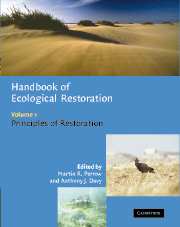Book contents
- Frontmatter
- Contents
- List of contributors
- Foreword
- Preface
- Part 1 The background
- Part 2 Manipulation of the physical environment
- Part 3 Manipulation of the chemical environment
- Part 4 Manipulation of the biota
- 12 Establishment and manipulation of plant populations and communities in terrestrial systems
- 13 Ecology and management of plants in aquatic ecosystems
- 14 Micro-organisms
- 15 Terrestrial invertebrates
- 16 Aquatic invertebrates
- 17 Fish
- 18 Reptiles and amphibians
- 19 Birds
- 20 Mammals
- Part 5 Monitoring and appraisal
- Index
- References
20 - Mammals
Published online by Cambridge University Press: 29 December 2009
- Frontmatter
- Contents
- List of contributors
- Foreword
- Preface
- Part 1 The background
- Part 2 Manipulation of the physical environment
- Part 3 Manipulation of the chemical environment
- Part 4 Manipulation of the biota
- 12 Establishment and manipulation of plant populations and communities in terrestrial systems
- 13 Ecology and management of plants in aquatic ecosystems
- 14 Micro-organisms
- 15 Terrestrial invertebrates
- 16 Aquatic invertebrates
- 17 Fish
- 18 Reptiles and amphibians
- 19 Birds
- 20 Mammals
- Part 5 Monitoring and appraisal
- Index
- References
Summary
INTRODUCTION
Some 4600 mammal species are recognised world-wide, encompassing an extraordinarily diverse range of life history, morphology and ecological roles. For example, just over 900 species are bats (Chiroptera), making them the second largest order of mammals after the rodents, while around 85 species are in the entirely marine order, Cetacea. Mammals range from Savi's pigmy shrew (Suncus etruscus) which can weigh less than 3 g and live only a few months, to immense blue whales (Balaenoptera musculus) weighing around 100 tonnes, which some evidence suggests may live two centuries or more.
According to the estimates of the International Union for the Conservation of Nature (IUCN – The World Conservation Union), compiled in collaboration with the Committee on Recently Extinct Organisms, 83 species of mammals have become ‘Extinct’ in the last 500 years while at least another four are considered ‘Extinct in the Wild’, the most famous example being Przewalski's horse (Equus przewalskii). The 2000 IUCN Red List of Threatened Species lists some 1130 mammal species classed in the top three threat categories, including 180 species classed as ‘Critically Endangered’, 340 as ‘Endangered’ and 610 as ‘Vulnerable’. In addition, 74 species are considered ‘Lower Risk/Conservation Dependent’, and another 602 species as ‘Lower Risk/Near Threatened’. Altogether, more than a third of known mammal species are represented on the IUCN list, and at least a quarter face extinction in the near future, either directly or indirectly as a result of human activities.
- Type
- Chapter
- Information
- Handbook of Ecological Restoration , pp. 389 - 408Publisher: Cambridge University PressPrint publication year: 2002
References
- 4
- Cited by



